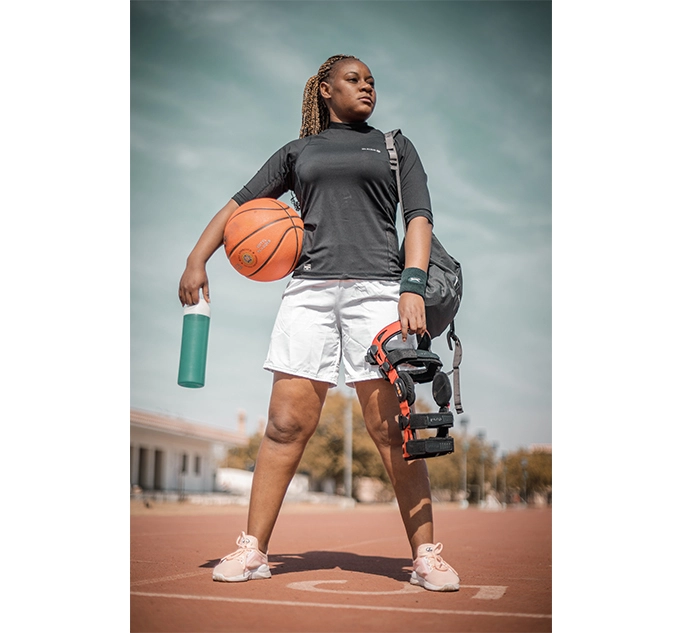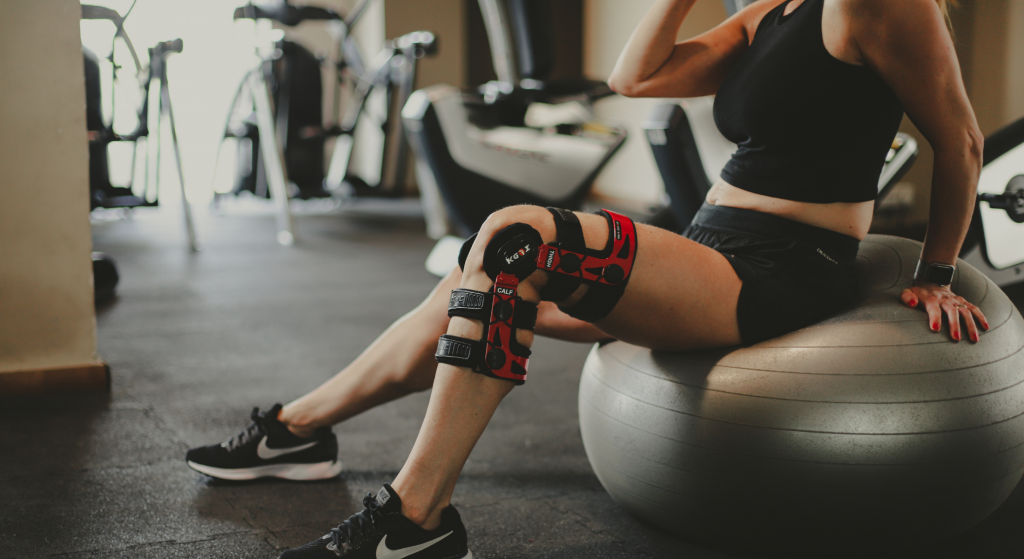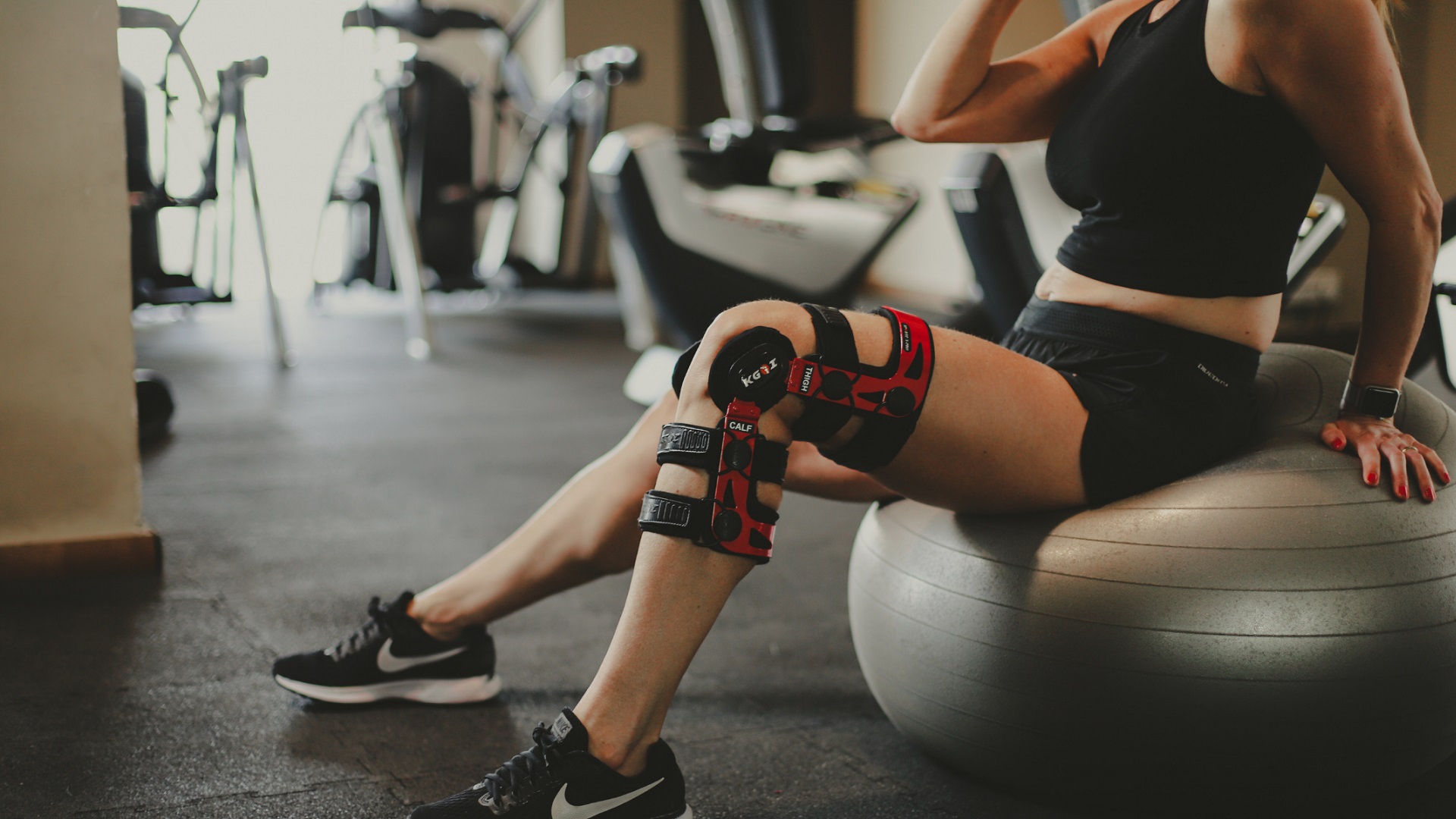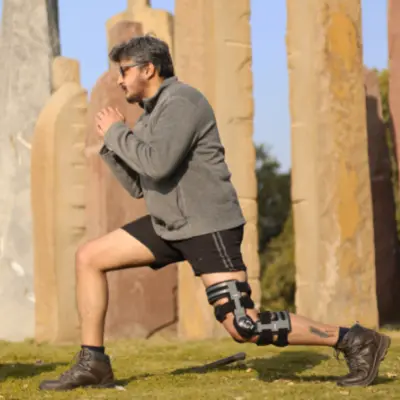Navigating through the discomfort of knee pain or the unpredictability of an unstable knee can often feel like a lonely journey. Whether it stems from an unexpected twist during last weekend’s game, years of battling arthritis, or simply aiming to level up your athletic abilities, finding that light at the end of the tunnel is what we all seek.
Trust me you’re not alone in this. Our own paths have led us down many aisles and through countless conversations with orthopedic specialists in search of answers. What stood out every time was how crucial a role the right knee brace plays not only in managing pain but also in paving the way toward regaining strength and mobility.
This guide is crafted to demystify the process for you, breaking down everything from identifying which support level matches your situation best to what makes a knee brace fit just right.
We delve into insights gained not just from our personal trials but fortified by expert recommendations on steering towards optimal knee health.
So let’s embark on this journey together towards finding your perfect fit and stepping into relief with confidence.
Key Takeaways
- Knee braces offer different levels of support from mild to maximum, depending on your needs such as ACL injuries, arthritis pain, or enhancing recovery.
- To find the right knee brace, identify where you need support and consider factors like injury type, desired mobility level, and stability needs.
- Consult with healthcare professionals when choosing a knee brace to ensure it meets your specific condition effectively.
- Wear the correct size of knee brace for optimal support and comfort; adjust straps securely but comfortably to avoid restricting movement.
- Regularly clean and inspect your knee brace for wear and tear to maintain its effectiveness in supporting your knee and preventing further injury.
Understanding Knee Braces
Knee braces come in various types, ranging from mild to maximum support. They help stabilize and protect the knee while providing compression for comfort and enhanced recovery.
What is a knee brace?
A knee brace is a tool we use to support our knees when they’re not at their best. Think of it as a friend who’s always there to hold your knee steady, whether you’re recovering from an injury or just need extra help during activities.
We’ve found that wearing the right one can really boost how well our knees function, making movements smoother and more secure. Plus, it’s great for keeping pain at bay and adding stability so we can stay on the move without worrying too much about our knees giving out.
From our experience, there’s a variety of knee braces out there designed for everything from minor discomforts to major rehabilitation needs. Whether it’s for ACL injuries, patella support, LCL issues, arthritis pain or simply enhancing recovery and performance; finding the right fit plays a huge role in how effective the brace will be.
Listening to doctors’ recommendations has always steered us in the right direction towards selecting a brace that meets our specific needs – be those seeking relief from chronic pain or gaining back mobility post-injury.
Choosing correctly can mean all the difference between struggling with every step and walking confidently with ample knee support.
Related: Guide To Choosing Knee Braces For Support
Types of knee braces (mild to maximum support)
Knee braces come in various types and are designed to provide different levels of support, depending on the injury or condition. For mild support, there are compression sleeves that offer gentle pressure to promote blood flow and reduce swelling.
These are often used for discomfort relief and minor knee stability issues like muscle strains or tendonitis. Moving up to moderate support, hinged knee braces with metal or plastic bars help stabilize the knees after injuries such as ligament sprains or cartilage tears.
They prevent excessive movement while allowing flexibility for daily activities.
When it comes to maximum support, functional knee braces are designed for serious ligament injuries like ACL tears. These sturdy braces limit abnormal joint movement without compromising mobility, aiding in rehabilitation and protecting against re-injury during physical activities.
How knee braces work
KGOI Knee braces function by providing stability and support to the knee joint, reducing the risk of injury or strain. They help in improving alignment, controlling motion, and relieving discomfort.
Different types of knee braces work in various ways to cater to specific needs: some focus on ligament support while others aid in redistributing weight across the joint. Knee braces also limit excessive movements that could potentially worsen an injury.
By doing so, they assist in protecting and promoting recovery for those experiencing knee discomfort or instability.
Wearing a knee brace can improve mobility while minimizing pain, enabling individuals with injuries to engage in physical activities with confidence. Additionally, these supports enhance proprioception – our body’s ability to sense its position without relying on visual cues – which further aids in preventing further damage or misalignments within the knee joint, contributing towards overall joint stability.

Elite ACL Knee Brace
Identifying Your Needs
Identify where you need support and consider the purpose of knee support, including factors such as injury, pain, and stability.
Where do you need support?
When experiencing a knee injury, identifying the specific area needing support is crucial. Whether it’s the ACL, LCL, patella, or general stability and pain relief, understanding where you need support is essential in choosing the appropriate knee brace.
Factors to consider for determining the support needed include injury location, type of pain experienced, and desired mobility level. Proper identification of your specific needs will guide you to select the suitable knee support that aligns with your injury and recovery goals.
Choosing the correct type of knee brace largely depends on where you require support. Different types of braces cater to various conditions such as mild to severe injuries and surgical rehabilitation.
Understanding your unique requirements helps in selecting a knee brace tailored to address your specific areas of need. By identifying where you require assistance – be it protection during physical activities or enhanced recovery from an existing injury – allows for tailored rehabilitation solutions designed to improve mobility and alleviate discomfort.
In evaluating where you need support after a knee injury or for preventive measures, it is pivotal to determine how different types and styles of braces can aid in providing targeted support based on individual needs.
Recognizing these needs serves as a foundation for effectively pinpointing personalized care approaches that suit each person’s distinct preference – ensuring optimal comfort while fulfilling recuperative necessities.
Related: What Does a Knee Braces Do For Your Knee
Purpose of knee support (enhanced recovery, performance, mobility)
To attain enhanced recovery, performance, and mobility for knee injuries, it’s crucial to select the appropriate knee brace. The right brace can aid in recuperating from injury, improving athletic performance, and ensuring better movement capabilities.
Incorporating the correct knee support helps strengthen the joints while providing stability during physical activities. This leads to a reduction in pain and ensures faster recovery for conditions such as ACL injuries or arthritis-related discomfort.
By choosing an ideal knee brace designed for specific needs like protection during sports activities or alignment correction post-injury, individuals can experience improved mobility overall.
A suitable knee support not only aids in speedy rehabilitation but also plays a significant role in preventing further damage or recurring injuries. Selecting the best-suited braces facilitates optimal functionality of the knees and enhances agility while engaging in various physical pursuits.
The right type of knee support contributes significantly to recovering from injuries effectively; it improves athletic proficiency and bolsters overall joint mobility. With proper selection based on individual needs, individuals can experience accelerated healing processes along with enhanced aptitude across different physical endeavors.
Factors to consider (injury, pain, stability)
When choosing the right knee brace, it’s crucial to consider the specific injury or condition affecting your knee. Different types of braces are available for ACL, LCL, patella, and arthritis pain.
Understanding the nature of your injury allows for selecting a suitable knee support that aligns with your rehabilitation needs and provides the necessary protection and stability during recovery.
Pain relief is another critical factor to consider when selecting a knee brace. The level of comfort and relief from discomfort that a brace offers can significantly affect an individual’s adherence to wearing it consistently.
It’s essential to choose a knee support that not only addresses pain but also enhances overall mobility and helps in maintaining proper alignment while facilitating optimal function during physical activities.
Related: When are knee braces helpful?

Sportz X-pro ACL Knee Brace
Choosing the Right Knee Brace
Evaluate your knee condition and choose the appropriate brace for your specific needs. Discover more about finding the perfect knee support.
Evaluating your knee condition
When assessing your knee condition, it’s vital to consider the specific area that requires support. Identifying whether you need assistance with ACL, LCL, patella, or arthritis pain will help determine the most suitable type of knee brace for your needs.
It’s essential to note that a doctor’s recommendation and diagnosis play a significant role in this process. Additionally, understanding the purpose of knee support is crucial – whether it’s for enhanced recovery, improved performance during physical activities, or simply for better mobility in daily life.
This evaluation helps in selecting a knee brace tailored to address your particular injury or discomfort.
Another critical aspect when evaluating your knee condition is considering factors such as pain intensity level and stability requirements. Be mindful of any past injuries that might affect current support needs and overall comfort while using a knee brace.
Properly evaluating these aspects will guide you towards choosing the right level of support and comfort from various types of available braces.
Different types of braces for specific needs
Different types of knee braces are designed to address specific needs related to knee injuries and conditions. These include ACL, LCL, patella, and arthritis pain, among others. The variety of braces range from mild support for minor discomfort to maximum support for severe instability.
Each type targets different aspects such as protection, alignment, mobility, and function tailored towards injury prevention or rehabilitation. For instance, some are intended for improved recovery post-injury while others focus on enhancing performance during physical activities like sports or exercises.
It is crucial to evaluate the level of support needed and consider doctor recommendations when selecting the appropriate knee brace. This careful consideration ensures that the right balance between comfort and effectiveness is achieved in addressing the specific requirements of an individual’s knee condition.
Furthermore, a well-matched knee brace can significantly contribute to reducing pain and improving overall mobility while offering essential stability to the knee joint.
Proper fit and sizing
Selecting the right knee brace involves evaluating your knee condition, ensuring proper fit and sizing, and considering the level of support needed. Factors such as fit, comfort, and level of support should be considered when choosing a knee brace to ensure effectiveness in enhancing recovery or providing necessary stability during physical activities.
Consulting with a physical therapist can provide valuable guidance on selecting the best knee brace for specific knee issues.
Proper fitting and wearing schedule are crucial considerations when using a knee brace. The correct size ensures that the brace provides adequate support without causing discomfort or restricting movement.
It is advisable to follow doctor recommendations for sizing and usage duration to maximize the benefits of wearing a knee brace while minimizing any potential risks.
Understanding how to properly wear and maintain your chosen knee brace is essential for achieving optimal results in managing knee injuries or conditions. By addressing these aspects thoughtfully, individuals can select suitable braces tailored towards their unique needs effectively.
Tips for Wearing and Maintaining Knee Braces
Ensure proper fit of the brace to avoid discomfort and chafing. Regularly clean and inspect the brace for wear and tear, following manufacturer’s guidelines.
How to properly wear a knee brace
To properly wear a knee brace, ensure you select the right size by measuring the circumference of your thigh and calf. Position the knee cap in the center of the brace and fasten it snugly with straps to prevent slipping.
Make sure it fits comfortably, not too tight or loose, to provide adequate support without restricting movement. When wearing for physical activity or sports, adjust the brace accordingly to allow flexibility while maintaining stability.
For optimal results, it’s essential to follow recommended guidelines from your healthcare provider regarding how long and when to wear the knee brace. Remember that proper care is crucial; clean and maintain according to manufacturer instructions for durability and hygiene.
By wearing your knee brace correctly, you can assist in recovery, alleviate pain, and enhance mobility.
Recommended duration of use
After understanding how to properly wear a knee brace, it’s crucial to consider the recommended duration of use. It’s essential to follow the doctor’s advice on wearing your knee brace.
The right duration can vary based on your injury and recovery progress. For instance, mild support braces for daily activities may be worn for shorter durations compared to maximum support braces for intense physical activities or sports.
Thus, consulting a healthcare professional is vital in determining the appropriate duration for using your knee brace.
When it comes to choosing the correct duration of use, we recognize that consistency is key in reaping the full benefits of wearing a knee brace. In cases like ACL injuries or arthritis pain relief, following the prescribed schedule from your healthcare provider will help improve mobility and alleviate discomfort effectively over time.
Our suite aims not only to empower individuals with informative content but also highlights firsthand experiences shared by experts and individuals who have navigated through similar circumstances.
Proper maintenance and cleaning
After using your knee brace, it is crucial to clean and maintain it properly. Regular cleaning helps prevent the buildup of sweat, dirt, and bacteria that can cause skin irritation or infections.
Follow the manufacturer’s instructions for washing to ensure the longevity of your knee brace.
We recommend wiping down your knee brace with a mild soap solution and water after each use. Make sure to air dry it completely before storing to prevent mold or mildew growth. Additionally, check for any signs of wear and tear regularly, such as loose straps or damaged hinges.
Maintaining your knee brace in good condition will ensure its effectiveness in providing support and protection for your injury.
Ensuring proper maintenance and cleaning practices for your knee brace is fundamental in maximizing its lifespan and performance while reducing the risk of skin-related issues. Proper care allows you to continue benefiting from the support provided by the knee brace during recovery or daily activities.
Conclusion
So, we’ve covered understanding knee braces and identifying your needs. We’ve discussed selecting the right knee brace, wearing tips, and maintenance. How easy is it to apply these strategies? Want to learn more about how to choose the perfect one for you? Keep in mind that improving mobility and reducing pain are crucial.
FAQs
What is the purpose of a knee brace?
Knee braces are used for knee protection, mobility and alignment. They aid in knee rehabilitation and function, providing relief from pain caused by athletic injuries.
How do I choose the right type of knee brace?
Choosing the correct knee brace depends on factors like your specific needs for support and relief from pain. It’s important to consider these when selecting the appropriate knee support or determining the ideal one.
Can anyone use a knee brace?
Yes, both athletes suffering from sports injuries and individuals experiencing general knee pain can find suitable support with orthopedic braces.
Are all types of braces suitable for every kind of injury?
No, different types offer varying levels of protection and support; hence picking the right type is crucial depending on your need whether it’s for rehabilitation or improving mobility.
Where can I get advice about which type to choose?
You can consult with professionals in sports medicine who can guide you through identifying proper supports based on your unique situation, helping you opt for the right brace.



